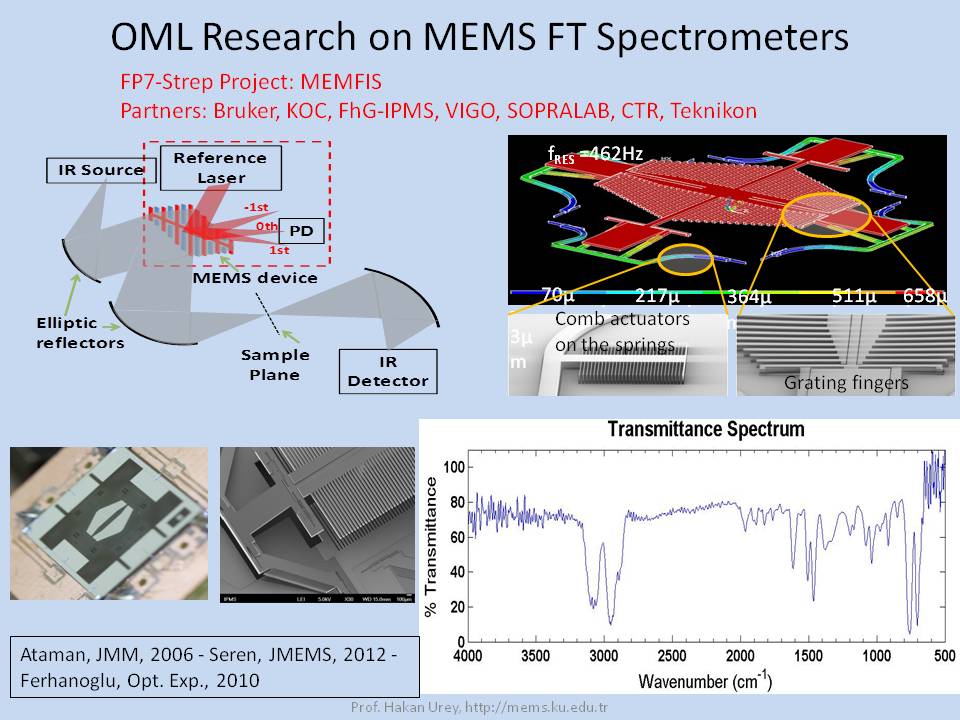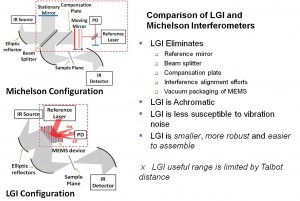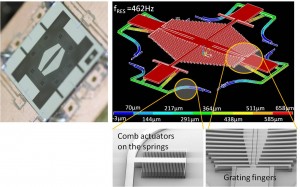 Fourier transform infrared (FTIR) spectroscopy is a widely used non-contact optical material characterization method with many applications, including chemical analysis of solids, fluids, gases, and process flows. FTIR utilizes a black body light source with broad spectrum, moving opto-mechanical components, and a detector. Current FTIR spectrometers offer good spectral resolution (few cm-1 or better); however, they are costly bench top laboratory instruments, require very high opto-mechanical precision, sensitive to vibrations due to interferometric detection principle, and have low measuring speed (few seconds to minutes). There is a latent demand for portable FTIR systems, as it would allow field use and has the potential to open up new research directions and applications.
Fourier transform infrared (FTIR) spectroscopy is a widely used non-contact optical material characterization method with many applications, including chemical analysis of solids, fluids, gases, and process flows. FTIR utilizes a black body light source with broad spectrum, moving opto-mechanical components, and a detector. Current FTIR spectrometers offer good spectral resolution (few cm-1 or better); however, they are costly bench top laboratory instruments, require very high opto-mechanical precision, sensitive to vibrations due to interferometric detection principle, and have low measuring speed (few seconds to minutes). There is a latent demand for portable FTIR systems, as it would allow field use and has the potential to open up new research directions and applications.

Most current commercial applications of FTIR use the well known Michelson configuration. An alternative approach is the lamellar grating interferometer (LGI). OML has been an important contributor to LGI spectrometer research for almost a decade. This enabled Koc University to join the the MEMFIS consortium as the only university. LGI is a dynamic diffraction grating operated at resonance and functions as a high-precision opto-mechanical interferometer with key important advantages compared to other types of interferometers. In the past LGI systems were too bulky to be of commercial use, but MEMS technology enable us to take advantage of the perks that make them especially suitable for compact and portable systems can be. A comparison between the LGI and the Michelson configuration is shown in Figure 1. In addition to the LGI-specific properties the main advantages offered by the MEMFIS devices are long travel range (good spectral resolution), a large clear aperture (high light efficiency), and very simple and robust system structure.
MEMFIS was a successful FP7 research project that lasted Aug 2008 – Feb 2012, where seven partners joined to develop the world’s smallest portable Fourier transform spectrometer. Within the project a Michelson-based spectrometer (developed by IPMS Fraunhofer) and an LGI-based spectrometer were developed in parallel. Koc University was responsible for development of the LGI device. The specific aims of the project was to build a miniaturized handheld FTIR spectrometer with high measuring speed (1-2 msec) and moderate spectral sensitivity (10 cm-1) across a wide wavelength range in the mid-infrared (2.5-16 μm) region.


A novel dynamic LGI-device is at the heart of the FTIR system and offers the required precision, speed, and vibration immunity for a portable system. The LGI MEMS device was designed at OML and microfabricated by our researchers at Center of MicroNanoTechnology (CMI) at EPFL, Lausanne, Switzerland. Images of the resulting device and and a view of the finite element model is shown in Figure 2. The device was subsequently integrated into a full bench top system (shown in Figure 3). The details of the device and the initial results were published in Journal Microelectromechanical Systems in 2012. The
